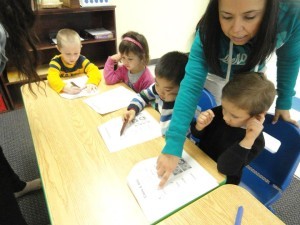Call Us Now! (512) 960-1514
Schedule Your Tour TodayMontessori schools integrate children within a three-year age span. Children up to three years old are placed in nurturing infant and toddler Montessori environments. Primary-aged children, from three to six years old, work together through distinct Montessori cycles of learning. Younger students benefit from imitating the older students, the older children develop confidence and leadership skills while reinforcing their own knowledge. This collaborative environment provides social benefits for each child. The cooperation and camaraderie in this environment is similar to that found in a healthy family.
 Teachers as Guides
Teachers as GuidesMontessori teachers have been rigorously trained beyond their university studies to guide children using self-discovered learning, a process of assistance, correction, and encouragement that promotes development of mind, body, and spirit. Teachers adjust to each child’s learning pace and needs and guide students to explore new topics and accept challenges. Although the teachers are guiding children through a complex process of engagement, learning, feedback, advancement, and teaching others, they primarily observe. To understand where children are in this process, teachers must observe and know them as human beings. They must see where students struggle, where they are excited, and where they become complacent. Montessori teachers’ firm, supportive, and kind demeanor is the key to the success of a Montessori school. They serve as role models of warmth, kindness, and respect, setting clear and consistent limits in a positive and supportive environment.
Montessori materials are essential to the success of the method. Although they do not have to be the exact same materials Dr. Montessori created when she began using her distinct method of education, there are certain traditional Montessori materials that have been proven successful through scientific research. The high-quality, carefully crafted materials lead children to discover and understand concepts in a hands-on and absorbing way. Each presents a distinct idea and has a self-correcting control to help children learn successfully and independently.
In a Montessori classroom, you will see certain beautiful, intriguing sets of materials that may not look like their subject matter at first glance. Long red rods teach children about increasing and diminishing length and balance. The Pink Tower and Brown Stairs materials help them to feel the difference in various measurements as well as introduce them to the base ten concept we use in mathematics. Tracing gorgeous tiles of sandpaper letters and numbers is a better first step to writing and spelling than the traditional tracing sheets. Paperwork and workbooks may be used in a Montessori classroom, too, but they are just two choices out of a myriad of hands-on opportunities for the children.
Children in Montessori schools may not bring home as many papers as their daycare or public school counterparts, but rest assured they are absorbing learning at the right pace and time and may eventually shoot far ahead of their peers in terms of academic skills.
 Beyond the Classroom
Beyond the ClassroomRegular field trips, in-school cultural events, and community service projects extend the world of the classroom and promote awareness of the community and compassion for others. The aim is to help children perceive and understand local, national, and global community needs. Some of Austin Children’s Academy’s school events include annual Earth Day plantings, Africa Day, monthly Music Days, recitals, peace ceremonies, Martin Luther King Jr. celebrations, and occasions to sing the national anthem at sporting events. ACA families participate in several festivals and fundraisers each year to give back to the local food bank, Brown Santa programs, Make-A-Wish Foundation, and more.
7:30am-6:00pm